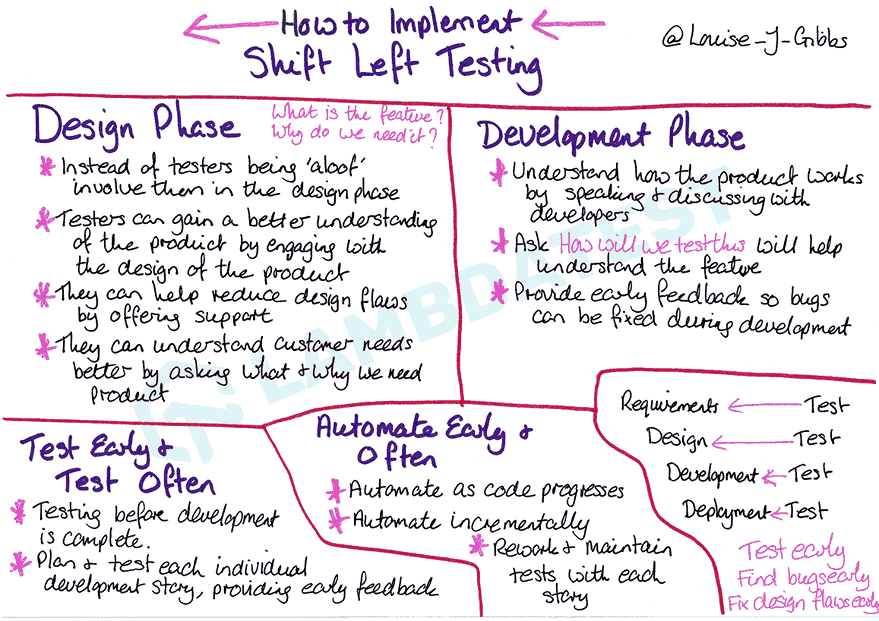Introduction to Shift Left Testing
Anshita Bhasin
Posted On: January 18, 2023
![]() 13340 Views
13340 Views
![]() 8 Min Read
8 Min Read

Shift-left testing is a software testing approach where testing is moved to an earlier phase in the development process, closer to the development phase. The goal of shift-left testing is to catch and fix defects as early as possible in the development cycle, which can save time and resources in the long run.
A real-time example of shift-left testing is in a microservices architecture where each service is developed and tested independently before being integrated with other services.
For example, My team is developing a payment page for an airline platform that involves new microservice for managing shopping cart and order service. The development team begins by writing unit tests for the cart and order service, which test the individual functions and methods of the service.
Once these tests pass, the team can proceed to integration testing, where the both services (cart and order) are tested against other services in the platform to ensure that it works as expected.
Once the development and testing of the both services (cart and order) is completed, it is then deployed to a staging environment where it is tested again. If there are any issues found in staging, they are resolved and the service is deployed to production.
By performing testing early in the development process, the team can catch and fix defects early on, saving time and resources that would have been spent on later stages of testing.
It’s also important to note that shift-left testing is not only about testing earlier but also about involving the whole team in the testing process, where developers, QA, and ops collaborate to test, identify and fix issues, which leads to a more streamlined and efficient development process.
Adopting Shift left testing in a software development lifecycle
The software development life cycle (SDLC) is a process followed in an organization for a software project. It consists of various stages starting from planning, designing, developing, testing, deploying, and maintaining software. It is a framework that outlines the steps and activities involved in developing software, from the initial planning stages to the final deployment and maintenance of the software.
Adopting Shift left testing in a software development lifecycle improves the quality of the software and reduces the time and cost required to fix defects later in the process.
Below are some ways in which you can adopt to shift left testing in your organization:
- Involve testers earlier in the development process:
- Implement BDD/TDD Approach:
- Encourage developers to write unit testing:
- Conducting Internal Demo:
- Monitor test coverage:
- Use version control and code review:
- Automation Testing:
- Testing every component.
- Include security testing:
Testers should be involved in the development process as early as possible, to provide feedback and help identify defects. This involves working closely with developers, attending daily stand-ups, and participating in design and code reviews.
To implement shift left testing, organizations often follow Agile Methodology and have sprint ceremonies such as sprint grooming and sprint planning where both QA and Development teams are involved from the beginning.
During this time, QA can ask clarifying questions about requirements and provide inputs as well.
This approach has several benefits. The test cases prepared by QA can help developers think about scenarios they may not have considered. Additionally, QA may identify cases that were missed by the product owner, business analyst, or the person who is responsible for gathering requirements.
Identifying potential issues and creating test cases early in the development process can save time and effort later on. Without this early identification, issues may not be discovered until later stages of development or testing, at which point it may be more time-consuming and costly to make changes to address them.
Unit testing involves testing individual units or components of code to ensure that they are working correctly. It is an important shift left testing technique that can be used to identify and fix defects early in the development process. You can provide training on how to write effective unit tests, as well as tools and frameworks that can be used to automate unit testing.
Conducting an internal demo to the sprint team on the sprint closure day is an effective way to implement shift left testing. During this demo, team members can visually see the work completed in the previous sprint, including any changes or updates to the website or product.
This allows them to provide feedback and identify potential issues early on, rather than waiting for formal testing to be conducted later in the process.
By involving the entire team in the demo, you can increase the chances of identifying potential issues and gathering valuable feedback. This can help improve the quality and value of the product, as it will not only be tested by a dedicated tester at a later stage but also reviewed and assessed by the entire team. This task ensures all relevant scenarios are considered and necessary changes are made before the product is released.
Use tools to monitor test coverage or the percentage of code that is tested, to ensure that you are testing all relevant code. Using code coverage tools can help you in monitor test coverage and also helps in analysing your codebase and reports on the percentage of code that is covered by tests.
Use version control systems, such as Git, to track changes to your codebase and enable collaboration. Use code review to ensure that code is reviewed and tested by multiple team members before it is deployed.
For example, you might set up a code review process in which all new code is reviewed by at least one other team member before it is merged into the main codebase.
This can help identify and fix defects early on and improve the overall quality of your software. By incorporating these techniques into your shift left testing strategy, you can effectively identify and fix defects early in the development process, improving the quality and efficiency of your software
Automated testing can be used to test individual units or components of code as they are being developed, allowing you to identify defects early on. This can help reduce the time and effort required for testing later on and improve the quality of your software by identifying and fixing defects early in the development cycle.
For example, when developing microservices, you can use automated testing to perform component testing early in the development process. By preparing test cases based on the Swagger or Confluence page and calling the service directly from the feature branch, you can verify that the service is working as intended.
You can also write code in the same branch as the development team and check classes or enumerations that are being used to ensure that they meet the requirements.
By performing early testing, you can identify bugs and defects at an early stage of software development, improving the quality and efficiency of your development process.
Testing every component is an important aspect of shift left testing. If you are testing an API and not all of the API is developed, you can still test what is available and mock the response for the rest.
Using concepts such as stubs and drivers, you can focus on testing the ready components without worrying about what is not yet available. This can give you confidence that the developed components are working correctly.
Later, when the entire API is available for testing, you can quickly verify its functionality without spending a lot of time on testing that has already been covered earlier.
Additionally, you can concentrate on your API’s functioning in connection to other third-party APIs it communicates with during this testing phase. You can make sure your API is operating properly and consistently by evaluating various third-party API behaviours
Security testing should be integrated into the development process as early as possible, to identify and fix security vulnerabilities early on. This can involve using tools such as static analysis tools, dynamic analysis tools, and penetration testing tools to test the security of the software.
These tools can be used to test the security of the software early in the development process.
How shift left testing is beneficial?
Below are some of the points, in which shift left testing proves to be beneficial:

- Reduced time and cost: By starting testing earlier in the development process, organizations can catch defects earlier and reduce the time and cost of testing.
- Improved quality: By testing early and often, organizations can identify and fix defects before they become more complex and expensive.
- Enhanced collaboration: Shift left testing encourages collaboration between development and testing teams, which can improve communication and lead to a better understanding of the requirements and design of the software.
- Greater agility: Shift left testing can help organizations be more agile and responsive to changes in the market or business requirements, as it allows them to quickly identify and fix defects and make changes to the software.
Conclusion:
Shift Left testing is not a new approach but it has gained more popularity in recent years as organizations have sought to improve the efficiency and effectiveness of their software development processes.It is a valuable approach that can help organizations improve the quality of their software and reduce the time and cost required to develop it.
Got Questions? Drop them on LambdaTest Community. Visit now
















